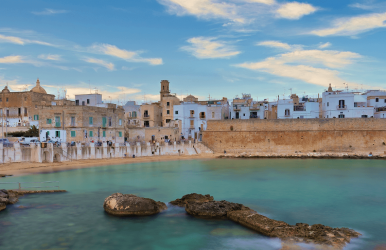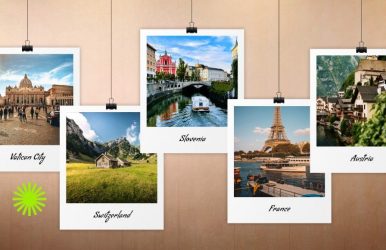What Are The Countries Near Italy? Know The Italian Neighbors And Why They Need To Be On Your Bucket List
BY
Sibashree
Aug 18, 2025
The best pasta!
Ruins that tell century-old stories!
Winding cobble streets that exude the perfect dark academia vibe!
The most luxurious villas and accommodations!
And sprezzatura, or the quintessential Italian sophistication!
All these things and more await you in Italy, and Italy never ceases to amaze you, as Mary Shelley said, “The Name of Italy has magic in its very syllables.”
So, it is no wonder that tourism in Italy is still going strong in 2025, and going by the predictions and data of the World Travel & Tourism Council (WTTC), Italy is all set to host WTTC’s 25th Global Summit from 28th-30th September, 2025, and break all tourism records.
WTTC is confident that:
Tourism in Italy will contribute € 237.4 billion to the Italian economy in 2025.
It will support 3.2 million jobs in 2025, and the number is 100000 more than in 2024.
From Daniela Santanchè, the Minister of Tourism in Italy, to Julia Simpson, the president and CEO of WTTC, everyone is proud and confident about the scenario. Julia Simpson has even mentioned,
“Italy is back at the top of travellers’ wish lists and for good reason. From the timeless beauty of Rome to the elegance of its coastlines, and countryside, Italy offers a unique experience steeped in history, culture, and exquisite luxury.”
However, overtourism still remains a concern, leading to visa rejections. So, in case you cannot visit Italy right now, you can always explore the countries near Italy.
With Italy at the heart of southern Europe, you can prepare for a greater European adventure by visiting the neighboring countries. Let’s tour and travel to France, Switzerland, Croatia, and other beautiful countries.
What Are 5 Countries Near Italy? What Are The Enclaved Microstates?
I will begin this section with a brief of the countries in Italy in a table format, and then discuss the borders and why you will love visiting these countries.
The five countries near Italy are 1. France, 2. Switzerland, 3. Austria, 4. Slovenia and 5. Croatia. The two enclaved microstates are San Marino and the Vatican City.
Countries Near ItalyBorder TypeBorder LengthPopular Entry PointsWhy Visit?FranceLand515 kmVentimigliaMont Blanc Tunnel• French Cuisine• Art and Museums• French Sophistication and Fashion• French Wine• The Beauty of Southern France, including the French Riviera and ProvenceSwitzerlandLand740 kmChiasso Simplon Pass• Lakes• Scenic Train Rides• Alpine Beauty• Swiss Chocolates• The 13th Happiest Country in the World**AustriaLand430 kmBrenner Pass• The 17th Happiest Country in the World**• Baroque Cities• Classical Music• The Land of Wolfgang Amadeus Mozart• Alpine Villages• Operas• Winter SportsSloveniaLand200 kmNear TriesteNova Gorica• Greenest Capital• Underground Wonders• Affordable DestinationCroatiaMaritime600 kmEastern Adriatic• Medieval Towns• Beautiful Coastlines• Dubrovnik’s Old TownSan MarinoEnclaved microstateN/AN/A• The Oldest Republic in the World• Built in 301 AD• Mount Titano• Guaita, Cesta, and Montale Towers• Unique Cultural Identity, even during the Italian Unification Movement in the 1800s• Tax-Free Shopping• A Country with No National DebtVatican CityEnclaved microstateN/AN/A• Home to the Pope• The Administrative and Spiritual Center of the Roman Catholic Church• The Vatican Museums• St. Peter's Basilica• The Sistine Chapel
** (Source: The World Happiness Report 2024)
1. France – The Most Visited Country In The World
1.4 billion!
Yes, that’s the number the World Tourism Barometer from UN Tourism has quoted for the number of international travelers to France in 2024.
The Summer 2024 Olympic and Paralympic Games have been two major factors behind the tourism boom, and France 24 has mentioned that France witnessed a year-on-year tourism growth of 12%.
However, France exudes a timeless appeal. The Eiffel Tower, luxurious tourism in Provence, the best wine and cheese! France is about all of these and even more!
Furthermore, the French-Italian border passes through the majestic Alps. It is one of the most breathtaking train rides or scenic drives in Europe.
Why Visit France?
Imagine yourself sitting in the balcony of a posh château in Nice or a luxury villa in Provence and sipping the best rosé wine. And of course, the glamor of the French Riviera!
French never ceases to amaze you. Moreover, Paris, the French Capital itself, offers iconic landmarks and the perfect French romance.
Tour And Travel Blog Bucket List Moments In France
Drive along the Côte d’Azur, stopping in Monaco, Cannes, and Saint-Tropez.
Visit Mont Blanc, the highest peak in Western Europe.
Spend a weekend in Paris, exploring the Eiffel Tower, the Louvre, and quaint street cafés.
UNESCO World Heritage Sites In France
Canal du Midi, etc.
Palace of Versailles
Our Lady of Chartres Cathedral
Cathédrale Notre-Dame d'Amiens
Mont Saint-Michel
2. Switzerland – The Land Of Eternal Ice And Romance
Have you experienced the flamboyance of Italy? It’s time to experience the charm of Switzerland, amidst ice and pristine lakes, mountain villages, and beautiful mountains.
Furthermore, blessed with the majestic Alps, Switzerland is a year-round destination, and once you explore the Switzerland Tourism official website, you will notice that the tourism attractions are as vivid as they can get.
Why Visit Switzerland?
Hop on a train from Milan and be in the snow-capped town of Zermatt or the luxury hub of Zurich in just a few hours.
Furthermore, Switzerland has the Matterhorn, a pyramid-shaped silhouette, and the most photographed mountain in the world. Also, Switzerland allows you to participate in adventure sports in Interlaken and the Bernese Oberland.
However, beyond every major attraction, it is the sustainable approach in Swiss tourism that wins me over every time.
The country has:
A total of 20 national parks
The designation as the water castle of Europe, with 6% of the fresh water reserve of the European continent
11,000 trains plying daily on SBB’s network, carrying 1.1 million passengers every day, ensuring sustainable travel even to the remote locations in Switzerland
Focus on recycling
Switzerland is one of the European countries that has the “lowest concentrations of particulate matter.”
Tour And Travel Blog Bucket List Moments In Switzerland
Take the Glacier Express for a panoramic train ride through the Alps.
Explore Lake Geneva and enjoy wine tasting in the Lavaux Vineyards.
Ski or hike in the Jungfrau region.
UNESCO World Heritage Sites In Switzerland
Aletsch Glacier
Convent of St. John Müstair
Bellinzona
Bern
Jungfrau, etc.
3. Austria: The Land Of History, Culture And Alpine Scenery
Austria is one of the most peaceful countries in the world. It has Vienna and Salzburg and many other world-class cities, and at the same time, it is the homeland of Strauss and Mozart.
It is also the birthplace of the Vienna Philharmonic Orchestra. Even today, Austria remains one of the cultural hotspots of Europe, thanks to its distinct coffee culture and the Salzburg Festival.
Furthermore, the Baroque and Romanesque architectural marvels of Austria add a unique visual appeal.
Once again being dominated by the Alps, Austria is a favorite destination for winter sports.
Why Visit Austria?
Along with the tourism attractions and the cultural extravaganza, Austria impresses us with its quality of life. The signature Austrian cleanliness, a well-developed and reasonable public transportation system, a strong legal system, and a low crime rate make Austria a safe tourist destination, even for solo female travelers.
Tour And Travel Blog Bucket List Moments In Austria
Visit Vienna’s grand Schönbrunn Palace and enjoy a classical concert.
Explore the storybook town of Hallstatt.
Ski in the Tyrol region.
Hike through the Austrian Alps in summer.
UNESCO World Heritage Sites In Austria
Welterbe Semmeringbahn (Info-Zentrum)
Vienna
Wachau
Salzburg
Schönbrunn Palace
Graz, etc.
4. Slovenia: A Country With A Green Capital
Ljubljana, the capital of Slovenia, is one of the greenest capitals in Europe. Further, it has iconic historical landmarks such as Ljubljana Castle.
Furthermore, Slovenia has Lake Bohinj, the largest natural lake in Slovenia and one of the most popular tourist destinations.
Also, Slovenia promotes an active tourism culture with activities such as cycling, water sports, and hiking.
Why Visit Slovenia?
Austrian cleanliness
Croatian coastal vibes
Italian warmth
Slovenia offers you all of these. Furthermore, Slovenia celebrates sustainable travel practices. The country has a national Green Scheme, and it is using technology to a great extent to make the travel scenario more eco-friendly and inclusive.
For example, the National Intelligence System for Tourism follows a data-driven approach to manage tourist inflow, avoid overtourism, and minimize the impact on the environment.
Furthermore, to balance visitor demands and environmental benefits, the hospitality sector in Austria follows eco-friendly practices.
So, it is no wonder that Slovenia, one of the closest countries near Italy, is called the Green Country.
Tour And Travel Blog Bucket List Moments In Slovenia
Row across the emerald waters of Lake Bled and visit its fairytale island church.
Wander around Ljubljana, one of Europe’s greenest capitals.
Explore the Postojna or Škocjan caves — massive underground wonders.
UNESCO World Heritage Site In Slovenia
Škocjan Caves
Heritage of Mercury
Plitvice Lakes National Park
The works of Jože Plečnik in Ljubljana – Human Centred Urban Design
5. Croatia – The Land Of Game of Thrones
“The most amazing set where I've shot 'Game of Thrones' is definitely Croatia, in Dubrovnik. It's such a stunning country with lots of good watersports there as well. Just a beautiful, beautiful place.”
- Natalie Dormer
All GOT fans! Can we not agree with what Margaery Tyrell has to say?
Croatia is perfect not only for those seeking the Sun but also for those interested in history.
It’s where Roman ruins meet Game of Thrones locations and beach days flow easily into lively nights.
Why Visit Croatia?
Croatia may not make headlines for exceptional tourism booms this year. However, as a Balkan paradise, Croatia, one of the countries near Italy, stands strong with its smart adjustments in seasonal offerings.
Dubrovnik, especially, a UNESCO World Heritage Site, is a favorite cruising destination thanks to its medieval structures and city walls.
It is trying to avoid the curse of overtourism with a sustainable approach and by promoting active tourism with outdoor activities such as hiking, ATV adventures, and cycling.
Moreover, Dubrovnik does not allow more than 4000 tourists on cruise ships. So, you must visit Croatia to see the fusion of Adriatic charm and sustainable tourism practices.
Tour And Travel Bucket List Moments In Croatia
Sail around the Dalmatian coast, stopping at islands like Hvar and Vis.
Visit Dubrovnik’s Old Town.
Explore Plitvice Lakes National Park, with its cascading waterfalls and scenic trails.
UNESCO World Heritage Sites In Croatia
Diocletian's Palace
Saint James’ Cathedral
Euphrasian Basilica
Trogir, etc.
6. San Marino: The Oldest Republic In The World
San Marino is one of the world’s oldest republics. Nestled entirely within Italy, tourists often skip this microstate, but it’s absolutely worth the detour.
Why Visit San Marino?
Besides bragging rights ("I visited a whole other country inside Italy!"), San Marino has medieval towers, and views from the mountaintops are stunning, with a pretty, unexpectedly vibrant cultural scene.
Tour And Travel Blog Bucket List Moments In San Marino
Climb to the top of the Guaita Tower for panoramic views.
Stroll the cobbled streets and explore the State Museum.
Time your visit with one of the many medieval festivals.
UNESCO World Heritage Sites In San Marino
The San Marino Historic Centre and Mount Titano is the UNESCO World Heritage Site in San Marino.
7. Vatican City: The Home Of The Pope
The Vatican is a country in its own right. While most people associate it with religion, the Vatican is also a cultural treasure chest.
Why Visit Vatican City?
Whether you’re spiritual or not, the Vatican holds some of the world’s most important art and architecture. And it’s an easy stop during any trip to Rome.
Tour And Travel Blog Bucket List Moments In The Vatican City
Marvel at the Sistine Chapel ceiling, painted by Michelangelo.
Visit St. Peter’s Basilica and climb to the dome.
Take a guided tour of the Vatican Museums for a deeper dive into history.
Frequently Asked Questions (FAQs) About The Countries Near Italy
Here are the frequently asked questions and answers about the countries near Italy.
1. Which Countries Near Italy Are The Most Beautiful? All the countries near Italy are beautiful. However, Switzerland is the most beautiful if you solely consider the scenic beauty, thanks to the Alpine grandeur. Furthermore, the Adriatic beauty, Croatia, has the most amazing coastline, and Slovenia looks serene with its lakes. 2. Which Countries Near Italy Have The Most Tourists? France, of course, is the Italian neighbor with the largest number of tourists. It is the most visited country in the world, and in 2024, it welcomed 1.4 billion international tourists. Croatia is another country that has a handsome tourist inflow, with the number of visitors reaching 21.3 million in 2024, according to Xinhua. 3. What Are The Most Peaceful And Less Crowded Coutries Near Italy? Austria and Slovenia are the most peaceful and least crowded countries near Italy. Despite a handsome tourist flow, the sustainable and technology-driven approach of these countries in tourism management helps them offer the most peaceful experience. San Marino is also quite peaceful, provided you avoid the peak seasons and plan a trip in the autumn or spring seasons.











